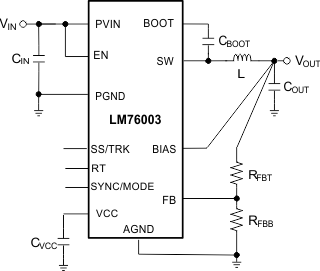TIDUE53I march 2018 – july 2023 TMS320F28P550SG , TMS320F28P550SJ , TMS320F28P559SJ-Q1
- 1
- Description
- Resources
- Features
- Applications
- 6
- 1System Description
- 2System Overview
-
3Hardware, Software, Testing Requirements, and Test Results
- 3.1 Required Hardware and Software
- 3.2 Testing and Results
- 4Design Files
- 5Trademarks
- 6About the Authors
- 7Revision History
2.2.6 LM76003
The LM76002/LM76003 regulator is an easy-to-use synchronous step-down DC/DC converter capable of driving up to 2.5 A (LM76002) or 3.5 A (LM76003) of load current from an input up to 60 V. The LM76002/LM76003 provides exceptional efficiency and output accuracy in a very small solution size. Peak current-mode control is employed. Additional features such as adjustable switching frequency, synchronization, FPWM option, power-good flag, precision enable, adjustable soft start, and tracking provide both flexible and easy-to-use solutions for a wide range of applications. Automatic frequency foldback at light load and optional external bias improve efficiency. This device requires few external components and has a pinout designed for simple PCB layout with best-in-class EMI (CISPR22) and thermal performance. Protection features include thermal shutdown, input UVLO, cycle-by-cycle current limit, and short-circuit protection. The LM76002/LM76003 device is available in the WQFN 30-pin leadless package with wettable flanks.
- Integrated synchronous rectification
- Input voltage: 3.5 V to 60 V (65 V maximum)
- Output current:
- LM76002: 2.5 A
- LM76003: 3.5 A
- Output voltage: 1 V to 95% VIN
- 15-µA quiescent current in regulation
- Wide voltage conversion range:
- tON-MIN = 65 ns (typical)
- tOFF-MIN = 95 ns (typical)
- System-level features:
- Synchronization to external clock
- Power-good flag
- Precision enable
- Adjustable soft start (6.3 ms default)
- Voltage tracking capability
- Pin-selectable FPWM operation
- High-efficiency at light-load architecture (PFM)
- Protection features:
- Cycle-by-cycle current limit
- Short-circuit protection with hiccup mode
- Overtemperature thermal shutdown protection
 Figure 2-7 LM76003 Simplified Schematic
Figure 2-7 LM76003 Simplified Schematic